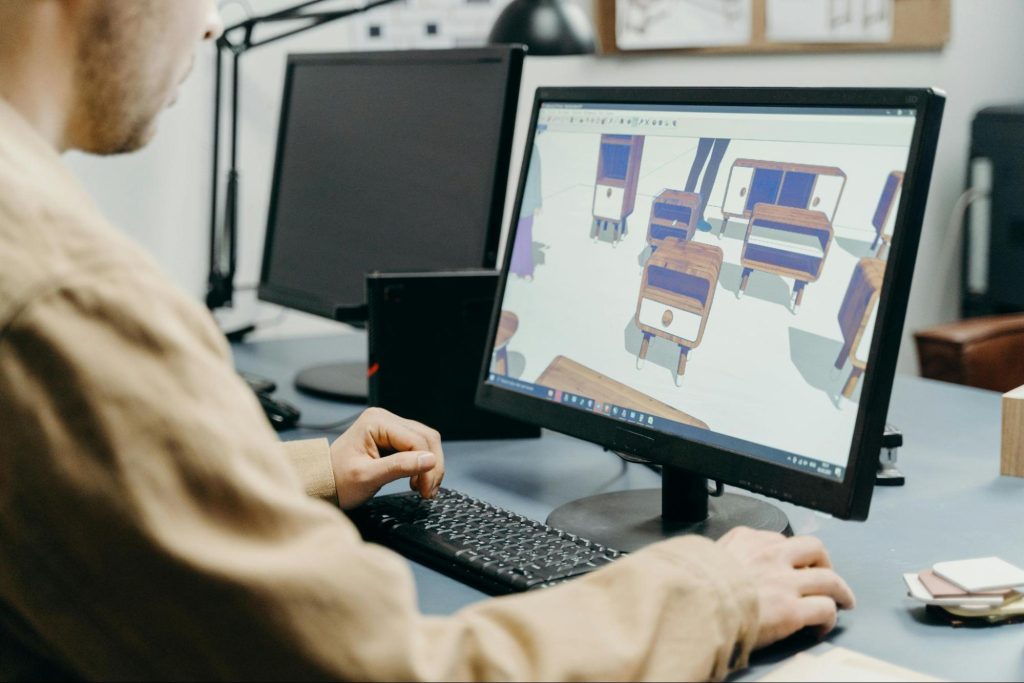ON THIS PAGE

For a free estimate and consultation, fill the form below and our team will get back to you as soon as possible.
The interior design SEO sector is highly competitive.
Having an online presence is integral to beating the competition and growing your business.
Search Engine Optimization (SEO) is an important piece to help people out amongst the search results online when they look for a service.
Today, we will check out the best practices to SEO your website that ranks on any search engine. So you can generate better-quality leads for your interior design business.
Target Relevant Interior Design Keywords
The building block of SEO is Keywords.
These are the words and phrases your ideal customer types into a search engine when looking for interior design services on the web.
You need to find keywords in your content that resonate with your target audience.
- Researching Keywords: Start by researching the keywords for interior design. Look for tools like Google Keyword Planner, SEMrush, or Ahrefs to try and find keywords that are not only relevant but also get a good decent search volume.
- Long-Tail Keywords: Long-tail keywords cause new websites to crawl in search of long-established competitors. For example, rather than the generic “interior design,” consider something like “modern living room interior design ideas” or “affordable kitchen remodeling services” instead.
- Localized Keywords: Use local keywords if your services are location-bound. Such as “Los Angeles interior designer” or “kitchen renovation Los Angeles.”
- Optimizing Content: Insert your targeted keywords into text-based content throughout the website—in the page titles, meta descriptions, headers, and body copy. Avoid keyword stuffing, as this can severely hurt your site’s ranking.
Build Your Local Presence to Attract Local Leads

Building a strong local presence is crucial for attracting local leads, especially relevant for interior designers.
While not every client may prioritize proximity, many prefer hiring professionals in their local area.
This is where creating a branch location or partnering with an SEO company in Los Angeles makes a lot of sense for top-of-the-funnel prospects.
- Google My Business: Claim and optimize your Google My Business (GMB) account. Ensure consistency of the business name, address, and phone (NAP) data across all referencing. Ask happy customers to write reviews—good reviews will boost your search rankings for local searches.
- Local Directories: One thing that sometimes gets overlooked but can’t be emphasized enough is listing your business in local directories ( Yelp, Houzz, Angie’s List, and many local Chamber of Commerce websites). These directories will help improve your online presence and give your website great backlinks.
- Local Content: Make the content that people of that region are looking for. Publish content about regional design trends in your blog, show completed projects in your city, or emphasize local businesses you work with. This improves your SEO and positions you as a local interior design authority.
Make Sure Your Site Loads Quickly to Keep Leads Engaged
Website speed is the SEO ranking score and a crucial part of user experience.
You also risk turning off potential customers quickly, thanks to a site that loads sluggishly and comes at the cost of a favorable search engine ranking.
- Optimize Images and Videos: If you have been adding a lot of video content, compressing your videos will speed up your website’s loading time. Well-compressed Images and Videos in standard quality (JPEG for images and MP4 for videos) have greatly compressed rates as well.
- Choose a Reliable Hosting Provider: Go for a good web hosting provider with fast server response times and guaranteed uptimes. To ensure fast loading times of website content across different locations, use a CDN (Content Delivery Network) with servers strategically placed in accessible areas to serve users efficiently.
- Minimize HTTP Requests: Cut down the elements per page, like scripts, stylesheets, and images. An HTTP request for each one of these can slow loading times. Optimize your assets and source files, concatenate where applicable, and use browser caching for repeat visitors.

Make Sure Your Site Is Mobile Responsive
The mobile-responsive site is obligatory when we talk about the intrinsic characteristics of user experience and website optimization scale because more people can access the web using tablets and smartphones.
- Responsive Design: Choose a platform and build your online site that best suits the mobile-friendly design. It makes your website fit perfectly onto any device and screen, delivering a uniform user experience on all platforms.
- Mobile Page Speed: Monitor how quickly your site loads its mobile pages. Run your website through tools like Google’s PageSpeed Insights to find areas for improvement. Minify images, do not let JavaScript and CSS slow down your pages, or wait any longer for the browser’s cache to improve the presence on your mobile.
- Mobile-Friendly Content: Make sure your content is easily read and navigated from mobile devices. Use readable fonts, enough space between elements, and buttons big enough to be touched with a finger.

Start a Blog to Increase Traffic to Your Site
Blogging is one of the effective strategies to get traffic to your interior design website, show your expertise, and improve your interior design SEO rankings.
- Content Strategy: Create a content calendar and blog posts around interior topics. Maybe you can answer some FAQs, show a few projects you’ve worked on recently, or give a quick tip on design/resources or trends in the field.
- Keyword Optimization: Use your target keywords in your blog posts organically. Answering exact queries and interior design subjects can help you appeal to organic traffic from search results.
- Visual Content: Include good-quality images in your blog posts and use videos to present your work visually. Visual content enriches the user experience and instigates social shares and backlinks.
- Promotion and Sharing: Promote your blog posts on social media and ask followers for shares. This encourages audience participation, which leads to more visibility and visitors to your website.
Get Started with SEO for Interior Design Today
Starting an interior design SEO business is lengthy and needs constant exercise.
These SEO practices will help you increase your online presence, generate specific leads, and grow your business.
- Consistent Monitoring and Adaptation: SEO is not a one-day activity. It’s an ongoing process that should be monitored consistently. Regularly check how your website is performing via Google Analytics and Search Console. Monitor keyword rankings, traffic sources, and user behavior to see where changes should be made.
- Stay Updated with SEO Trends: Keep track of SEO trends. SEO is a dynamic field. Stay in the loop on the latest algorithm changes, trends, and SEO best practices for interior design. Change strategy as needed to strengthen your position in the long term and much more.

Utilize Social Media for Brand Awareness and Engagement
Social media can help promote your interior design business, engage with prospects, and drive traffic via one post at a time.
- Choose the Right Platforms: Determine where your users will most likely be when using a social media platform. Platforms such as Instagram, Pinterest, and Houzz have a significant interest from users.
- Visual Content: Post visual content by taking photographs and videos of your sends before and after transformations, design inspirations, and behind-the-scenes. Social media also works great for visual content, as images receive high engagement again.
- Engage with Your Audience: Reply to comments, messages, and queries immediately. Knowing your audience will make your brand seem more genuine and reliable. Get followers talking about your content by posting a caption that asks for their opinion or for them to share something similar.
Conclusion
Optimizing your interior design website for search engines will ensure you meet new clients and expand your practice in the digital era we live in today.
Target crucial keywords, emphasize local friendliness, improve website load times, prioritize mobile responsiveness, launch a blog, and continuously optimize your strategies to enhance online visibility and engagement.
Targeting keywords, establishing local presence, faster load times, mobile responsiveness, blogging, and continuous optimization boost internet visibility and attract qualified leads.
It is important to keep in mind that SEO is not a same-day relief but rather an investment in the long-haul success of your interior design business.
Follow SEO best practices and use them to consistently optimize your site.
You will set yourself apart as the leading source of your services in your local area and target markets, making it easier for clients looking for someone like you to find.
Start SEO for interior design today and witness your online presence and business flourish.
FAQs
1. What is Interior Design SEO?
Interior Design SEO involves optimizing a website to improve its visibility in search engine results for interior design-related keywords.
2. Why is SEO important for interior designers?
SEO helps interior designers attract potential clients who are actively searching for their services online.
3. How can interior designers benefit from local SEO?
Local SEO helps interior designers attract clients in their geographic area by optimizing for location-specific keywords and listings.
4. What are the best practices for keyword research in interior design SEO?
Keyword research should focus on identifying relevant and specific terms that potential clients use when searching for interior design services.
5. How can interior designers optimize their websites for mobile devices?
Interior designers can optimize their websites for mobile devices by using responsive design principles and ensuring fast loading times.
6. Why should interior designers start a blog for SEO?
Blogging allows interior designers to regularly publish content that targets specific keywords, improves SEO, and showcases expertise.
7. How can interior designers measure the success of their SEO efforts?
Interior designers can measure SEO success through tools like Google Analytics, which tracks website traffic, user behavior, and keyword rankings.
